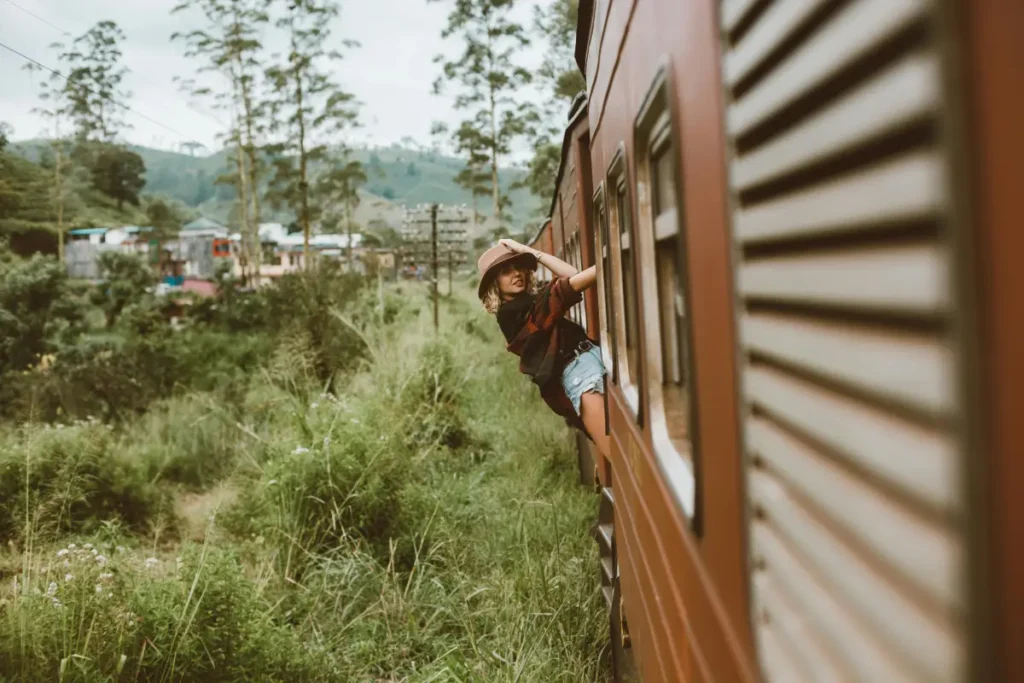
Ella Sri Lanka Emerald Mountain Paradise
Nestled in Sri Lanka’s verdant highlands, Ella is a tranquil mountain village that has emerged as one of the country’s most beloved destinations. This small town, situated approximately 200 kilometers east of Colombo, captivates visitors with its dramatic landscapes, tea plantations, and laid-back atmosphere. Combining natural beauty with rich cultural heritage, Ella presents a perfect blend of adventure and relaxation for travelers seeking an authentic Sri Lankan experience.
A Geographic Wonder
Ella sits at an elevation of approximately 1,000 meters above sea level in the Badulla District of Sri Lanka‘s Uva Province. The region’s topography is characterized by rolling hills, deep valleys, and lush forests that create a picturesque setting throughout the year. The area’s moderate climate – cooler than the coastal lowlands but warmer than the highest central highlands – provides ideal conditions for vegetation to flourish, resulting in the vibrant greenery that has become Ella’s signature feature.
The town is surrounded by notable peaks including Ella Rock, Little Adam’s Peak, and the imposing Namunukula mountain range. These formations create a dramatic backdrop that’s particularly striking at dawn and dusk when misty clouds often envelop the summits. The region experiences two monsoon seasons annually, contributing to the area’s biodiversity and agricultural prosperity.
Historical Significance
Long before becoming a tourist hotspot, Ella held strategic importance in Sri Lanka’s colonial history. The British, who colonized the island from 1815 to 1948, recognized the area’s potential for tea cultivation due to its ideal climate and elevation. They established extensive tea plantations across the region, forever changing the landscape and economy of Ella and its surroundings.
Evidence of this colonial past remains visible throughout the area, particularly in the railway infrastructure. The famous Ella railway station, part of the scenic mountain railway constructed by the British in the late 19th century, stands as a testament to colonial engineering and has become an iconic landmark in its own right.
Prior to British colonization, the region was part of the Kandyan Kingdom, the last independent kingdom of Sri Lanka. Local legends and place names reflect this rich pre-colonial history, with connections to the Ramayana epic and other ancient tales woven into the cultural fabric of the area.
Natural Attractions
Ella’s popularity largely stems from its stunning natural landscape and the abundance of outdoor activities available. Most visitors prioritize hiking up to Ella Rock, a challenging but rewarding trek that offers panoramic views of the surrounding mountains and valleys. The trail takes hikers through tea plantations, forests, and along railway tracks before the final ascent to the summit.
Little Adam’s Peak, named after the sacred Adam’s Peak mountain in central Sri Lanka, offers a more accessible hiking option with equally impressive views. The well-maintained path leads through tea estates to several viewpoints that showcase the dramatic scenery of the Ella Gap, a valley that opens toward the southern plains.
Ravana Falls, a 25-meter cascade located just outside Ella, is another natural attraction with mythological significance. According to the Ramayana epic, King Ravana hid Princess Sita in caves behind these falls after abducting her from India. The multi-tiered waterfall is particularly impressive during the rainy season when water volume increases dramatically.
The Nine Arch Bridge, officially known as the Demodara Nine Arch Bridge, represents both a natural and architectural marvel. This colonial-era railway bridge spans 91 meters across a deep valley, supported by nine massive arches. Surrounded by dense jungle and tea plantations, the bridge creates a photogenic scene that has become one of Sri Lanka’s most recognizable images.
Tea Heritage
Ella’s identity is inextricably linked to tea production. The surrounding hillsides are carpeted with tea plantations that create a mesmerizing patchwork of green. These estates not only contribute to the scenic beauty but also offer visitors insight into the tea production process that has been central to Sri Lanka’s economy for over 150 years.
Several tea factories in the area open their doors to tourists, providing guided tours that demonstrate the journey from leaf to cup. Visitors can observe the withering, rolling, fermenting, drying, and grading processes that transform fresh tea leaves into the finished product. These tours typically conclude with tea tasting sessions that highlight the distinctive flavors of high-grown Sri Lankan tea.
The laborers who work in these tea estates, predominantly of Tamil origin, are descendants of workers brought from South India during British colonial rule. Their communities, culture, and traditional practices add another layer to the cultural landscape of Ella, though their history also represents a complex legacy of labor exploitation and ongoing socioeconomic challenges.
Culinary Experiences
Ella’s food scene has evolved to cater to both international visitors and those seeking authentic Sri Lankan cuisine. Traditional dishes like rice and curry feature prominently, with local restaurants offering variations that showcase the island’s diverse culinary heritage. Fresh vegetables, aromatic spices, and coconut milk form the foundation of many local dishes, reflecting the agricultural abundance of the surrounding region.
The area’s growing popularity has also led to the emergence of cafés and restaurants serving international cuisines, particularly focusing on healthy, organic options that appeal to the predominantly young, adventure-seeking travelers who visit Ella. Many establishments emphasize locally sourced ingredients, with some even maintaining their own garden plots to supply fresh produce.
Street food vendors and small family-run eateries offer opportunities to sample local specialties like hoppers (bowl-shaped pancakes), kottu roti (chopped flatbread stir-fried with spices and meat or vegetables), and various sweet treats made with local jaggery (palm sugar). The area’s tea culture naturally extends to the dining experience, with many establishments offering specialty teas and tea-infused dishes.
Transformation into a Tourist Hub
Over the past decade, Ella has transformed from a quiet mountain village into a bustling tourist destination. While still retaining much of its charm, the main street now features numerous guesthouses, restaurants, and shops catering to international visitors. This rapid development has brought both opportunities and challenges to the local community.
The tourism boom has created employment opportunities and economic growth, with many local families converting their homes into guesthouses or establishing small businesses. At the same time, concerns about overdevelopment and environmental impact have emerged as the town expands to accommodate growing visitor numbers.
Despite these challenges, Ella maintains a more relaxed atmosphere compared to Sri Lanka’s busier tourist centers. The influx of travelers has created a unique social environment where visitors from around the world mix with locals in a setting that combines traditional Sri Lankan hospitality with modern amenities.
Cultural Experiences
Beyond natural attractions, Ella offers various opportunities to experience Sri Lankan culture. Local cooking classes have become popular among visitors wanting to learn the secrets of Sri Lankan cuisine. These hands-on sessions typically include a visit to the local market to purchase ingredients, followed by preparation of traditional dishes under the guidance of local cooks.
Traditional Ayurvedic wellness practices have also found a place in Ella’s tourism offerings. Several spas and wellness centers provide treatments based on this ancient system of medicine, which originated in the Indian subcontinent and has been practiced in Sri Lanka for centuries. These treatments often incorporate locally grown herbs and spices believed to have healing properties.
Religious sites in and around Ella provide insight into the island’s spiritual traditions. Dowa Raja Maha Viharaya, an ancient rock temple featuring a 38-foot unfinished Buddha statue carved into a rock face, stands as a testament to the area’s Buddhist heritage. The temple complex, dating back to the Kandy period, contains paintings and sculptures that illustrate stories from Buddhist teachings.
Sustainable Tourism Initiatives
As awareness of tourism’s environmental impact grows, Ella has seen the emergence of eco-friendly initiatives aimed at preserving the area’s natural beauty. Several accommodations and tour operators now emphasize sustainable practices, from reducing plastic waste to supporting conservation efforts in the surrounding forests.
Community-based tourism projects have also developed, allowing visitors to engage more meaningfully with local communities while ensuring that tourism benefits are distributed more equitably. These initiatives often include homestays, village walks, and craft demonstrations that showcase traditional skills like weaving and woodcarving.
Conservation projects focusing on the area’s biodiversity have gained traction, with efforts to protect native plant species and wildlife habitats. Educational programs for both locals and visitors highlight the ecological importance of the region and promote responsible tourism practices.
Practical Information for Visitors
Travelers typically reach Ella by train from Kandy or Colombo, a journey that has been consistently rated among the world’s most scenic railway routes. The slow-moving train winds through tea plantations, forests, and mountains, offering spectacular views throughout the seven-hour journey from Kandy.
Accommodation options in Ella range from budget guesthouses to luxury boutique hotels, with many offering stunning views of the surrounding landscape. The most sought-after properties perch on hillsides overlooking the Ella Gap, providing guests with breathtaking vistas from their balconies or terraces.
The best time to visit Ella is during the dry seasons from December to March and from June to September, when rainfall is minimal and hiking conditions are optimal. However, the area’s temperate climate makes it a year-round destination, with the misty monsoon periods offering a different but equally captivating experience.
Looking Forward
As Sri Lanka continues to develop its tourism sector following recent challenges including the COVID-19 pandemic and economic difficulties, Ella stands at a crossroads. The balance between economic development and environmental preservation remains delicate, with ongoing discussions about how to manage tourism growth sustainably.
Infrastructure improvements, including better road connections and public facilities, are gradually enhancing visitor experiences while potentially opening the area to larger tourist numbers. At the same time, there’s growing recognition of the need to protect the natural environment that makes Ella special.
For now, Ella remains one of Sri Lanka’s most enchanting destinations – a place where natural beauty, cultural heritage, and warm hospitality combine to create an unforgettable experience for travelers seeking to explore the island’s highland treasures.
Conclusion
Ella encapsulates much of what makes Sri Lanka a compelling destination: dramatic landscapes, rich biodiversity, cultural heritage, and the warmth of its people. From the mist-shrouded mountains to the vibrant green tea plantations, from colonial history to contemporary tourism experiences, this mountain village offers a multi-faceted glimpse into the heart of Sri Lanka.
As visitors stand atop Ella Rock watching the sunrise illuminate the valleys below, or sip locally grown tea while gazing at the Nine Arch Bridge, they experience the unique magic that has made this once-sleepy town a highlight on the Sri Lankan tourist trail. Despite its growing popularity, Ella retains an authenticity and charm that continues to captivate travelers from around the world, securing its place as one of the island’s most beloved destinations.
